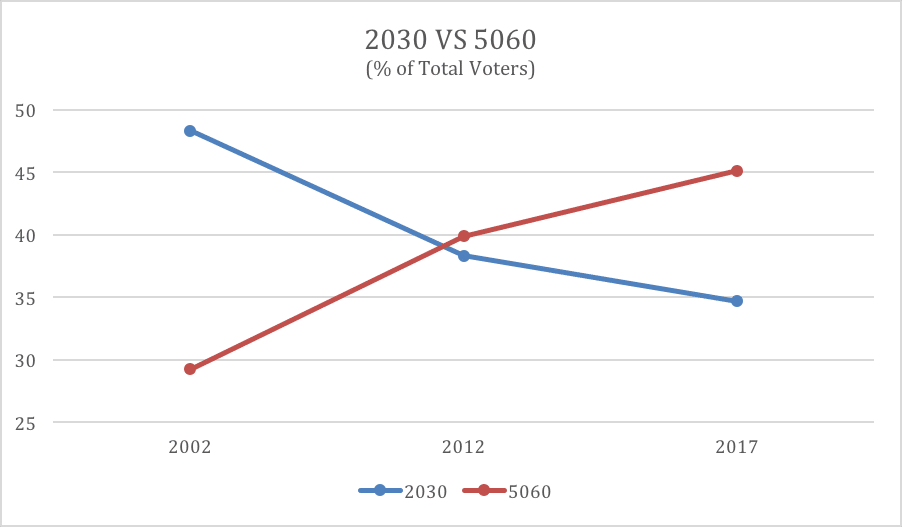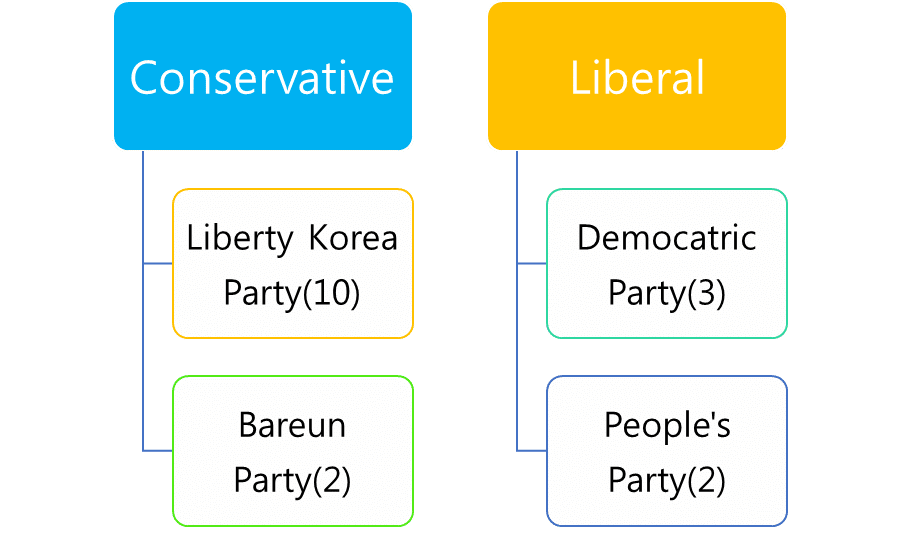InAsia
Insights and Analysis
Snap Election in South Korea: What You Need to Know
March 15, 2017
On March 10, South Korea’s Constitutional Court removed President Park Geun-hye from office after she was impeached over a massive corruption scandal. An election to choose her successor must be held by May 9, leaving less than two months for potential candidates to campaign. This political drama takes place at the same time as several other major challenges that have captured the public’s attention, including investigation proceedings over Samsung Corp. and Park, and growing tensions over North Korea’s recent actions, to name a few. It is said that an election isn’t over until all ballots are counted and there is nothing to be taken for granted in Korean politics. But here are some key points to help understand the coming election.
Tight, Too Tight
The May presidential election will be very different from past elections, primarily because this will be a snap election. All campaigning must be completed within 60 days. The period is very tight—in the last election in 2012, Ms. Park was officially nominated as the candidate of her own party on August 20 of that year, four months before the election.
As shown in the graph above, the candidates for the 2012 election enjoyed 240 days of campaigning after the candidate registration deadline, compared to 60 days for candidates in this year’s election. And, with only two months remaining, no party has even finished its candidate nomination process. In fact, some parties announced only earlier this week that they were going to set up a committee to oversee the process.
In this case, the establishment is likely to have the upper hand. There is simply not enough time for all the parties to identify and articulate platforms for someone entirely new to the playing field. Given the rushed timeframe, party members may opt for more well-known, proven candidates to avoid any surprises. The same selection standard may also be applied to the political parties themselves, which could mean that an older and larger party may have a higher probability to beat a newer, smaller one.
The victor will be immediately sworn in as the new president of Korea and take office right after the outcome of the election is officially announced and confirmed. There will be no luxury of having a presidential transition period of three months which other past presidents-elect have enjoyed. In the worst-case scenario, the newly elected president launches his or her presidency with the same policies and cabinet members of the Park administration. So, the rule of thumb that something new and fresh is always attractive and advantageous in an election, may not apply to this one.
10 Million Grey Voters
Liberal candidate Moon Jae-yin, Democratic Party of Korea chief who ran against Park in the 2012 election, commands a clear lead in the polls and has been enjoying high approval ratings since February (see chart below).
However, the demographic structure of South Korean voters is often not favorable to the candidate from the reformist camp. This is the first time in election history that the total number of so-called “5060” voters (those who are older than 50) exceeds 10 million, or about 45 percent of total voters.
Like other countries, age is a strong predictor of Korean voting behavior. Generally speaking, older people are more likely to vote for conservative candidates, while younger voters are more likely to vote for liberal ones. This will likely be an important indicator in Korea’s upcoming election. When the last candidate nominated from the liberal camp, Mr. Rho Moo-hyun, won the presidency in 2002, the number of “5060” voters accounted for less than 30 percent of total voters, while the number of “2030” voters (those younger than 39) accounted for about 50 percent of total voters (the remaining bloc of voters are in their 40s). Most agree that Mr. Rho was elected thanks to the fervent support of the majority 2030 voters. But today, just 15 years later, the demographics have shifted, with the 5060 voters now in the majority at around 45 percent, and 2030 voters at 35 percent.
Mr. Moon felt the blow of this voter demographic structure in the 2012 election in which he garnered 48 percent, or 14,692,632 of the votes, making him the second-highest candidate in terms of number of votes among all the presidential candidates in the past five presidential elections. However, the 2012 election was also the first time in South Korean history where the number of 5060 voters surpassed that of 2030 voters. When grey voters cast their ballots in droves for Ms. Park, she beat Mr. Moon in a narrow victory, making her the first and only candidate to garner over half (51.6 percent) of the votes in Korean history.
Splitting and Merging
Another important issue to look out for in the upcoming election is the “splitting” of parties. This election marks the first time since 1987 that four different parties are competing in a presidential election. Among these four parties, two parties are liberal and two are conservative. While the split in the reformist circle is not surprising, it is very rare for the conservative party to split into two warring factions. The division among conservative parties is largely considered to be a backlash from the contentious impeachment of President Park in December last year. With the conservatives divided, the liberal party is well positioned to retain power again.
(the number in parentheses represents the number of potential candidates)
Although the prospects remain uncertain, there is a possibility that the split conservative parties will move to unite in the next two months. This is because both conservative parties, the Korea Liberty Party and the Bareun Party, acknowledge that the conservative bloc should reunite to have at least a chance against the opposition group. And if the two conservative parties can unify around a single candidate, they could enjoy the loyal support of the majority conservative voters. In the last four presidential elections, conservative candidates garnered at least 46 percent of the votes (see graph below).
Therefore, the stakes for the conservative circle in this election depend largely on whether (and how soon) the split parties can come together.
The same is true, though likely less so, of the reformist bloc. While Mr. Moon enjoys a comfortable lead in the race and has the advantage of the lasting public anger against Ms. Park on his side, his approval rating remains in the low 30s, far behind the polling rate of 48.3 percent that he had five years ago in the 2012 election. This is because the progressive camp has divided into two parties, the Democratic Party and People’s Party, and at the same time, other potential candidates have emerged from within Mr. Moon’s own party. Thus, the Democratic Party plans to nominate a single candidate through the Party’s primary. And Mr. Moon, the chairman of the Democratic Party, seemed to express a desire to merge with the People’s Party when he said, “The People’s Party will eventually merge with our party ahead of the presidential election.”
There is still no way of forecasting whether Mr. Moon and his party can achieve these goals within 60 days or not. But, even if both sides succeed at unifying their parties and developing their campaign platforms and strategies, the candidate of the liberal camp will be heavily favored to win the presidency. And no matter who wins, they will face the challenge of trying to achieve long-term national policy impact in a five-year, single-term presidency in a race to pass legislation and institute new programs. It will not be surprising to see the debate surrounding constitutional reform for presidential terms heat up once again.
Kim Kyoungtae, editor at Munhwa Broadcasting Corporation in Seoul, is a leading political commentator in Korea. He is also 2017 Nieman Fellow at Harvard University, sponsored by The Asia Foundation. The views and opinions expressed here are those of the author and not those of The Asia Foundation or its funder.
1 Comment
About our blog, InAsia
InAsia is posted and distributed every other Wednesday evening, Pacific Time. If you have any questions, please send an email to [email protected].
Contact
For questions about InAsia, or for our cross-post and re-use policy, please send an email to [email protected].The Asia Foundation
465 California St., 9th Floor
San Francisco, CA 94104
The Latest Across Asia
Program Snapshot
April 18, 2024
News
April 17, 2024

2024 Lotus Leadership Awards
Thursday, April 25, 2024, New York City
The Lotus Leadership Awards recognize contributions towards gender equality in Asia and the Pacific












You comments are described usually by two dimmensions of conservative-progressive with age of 50-60 and 20-30. You are right and follwed current phenomena, However you missed other important realities behind of some people who are worrying about interkorean relationship. There are surely North Korean(NK) followers or connectors. NK is the highest oppresssive and anti-human rights regimes. I am 80 years’ old but strong supportor of liberal and human right truth which may be belonged to the progressive. The leaders with groups of NK follwers are still stong and almost fixed in NK guardians which are very dangerous. They opposed to take NK Human Right Law to reform and correct her dehumanization for more then 12 years.
We liberal Koreans, regardless of age and conservative-progressive, wish strongly to clear out from the corruptive president Parks and her father of dictator Junghee Park with Parks’ Lovers. We do not turn to NK followers in this hard situations, but to re-establish liberal democratic regimes under new liberal democratic leaders.
It is very hard: some leadr of Bareun Party are still in the circles of pro Parks of their back ground careers. Liberal Korea Party members are, many believe, almost all Parks’ followers.
We wish to be new liberalists who love democracy, and to go on peaceful unification